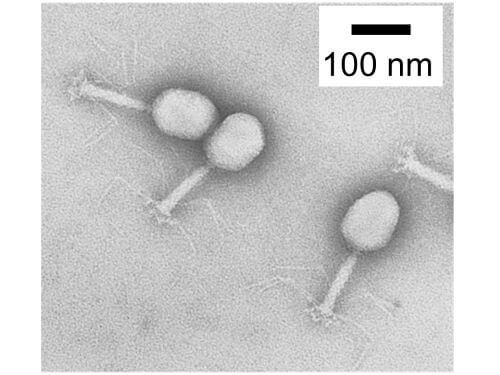Researchers demonstrated the benefits of a natural, non-radioactive dye by observing viruses at the nanometer level. The innovative substance is a structurally stable substance and is a natural molecule with a longer shelf life than the radioactive substance most often used for this purpose, uranyl acetate
[Translation by Dr. Moshe Nachmani]

Researchers can observe the smallest details at an atomic level using a transmission electron microscope (TEM) by projecting a beam of electrons through a sample and capturing their interactions in order to obtain an image. However, sometimes tiny samples may escape the electrons themselves, so they require special treatment using heavy metals in order to ensure the interactions that arise from them. In order to see viruses, for example, the current standard is to immerse the virus sample in a solution containing a radioactive substance called uranyl acetate. The resulting images are clear, but the process for obtaining and storing the solution of the radioactive heavy metal (uranium) may be a complex barrier for researchers, according to Masahiro Sadakane, a professor of applied chemistry at Hiroshima University in Japan. The researcher and his colleagues recently found that non-radioactive treatment can produce the same clear and detailed images, without the need for the radioactive material. The findings of their research were published in May in the scientific journal Scientific Reports.
"Observing the structure of viruses is an essential process in the field of virus research, for which a penetrating electron microscope is the most useful method since it allows direct observation at the nanometer level, but at the moment it requires the use of negative staining materials that contain heavy and radioactive elements," says the lead researcher. "Innovative and non-radioactive compounds, for simple, fast, and clear viewing for use with a penetrating electron microscope, are required all over the world." An available and commercial alternative to the radioactive substance today is a substance known as phosphotungstic acid of the "Keggin" type. The compound consists of a central unit of one phosphorus atom and four oxygen atoms, surrounded by other oxygen atoms and a tungsten atom. Although it is not radioactive, the substance is extremely acidic and must be neutralized before use, according to the lead researcher. He also notes that the resulting images are less clear than those obtained using the existing dye. However, despite these shortcomings, the new material belongs to a large group of similar compounds - and perhaps even more effective than the current one. "We are researching compounds from this family (phosphotungstate), and we have already reported in the past that such a "Preyssler" type compound can also be used as a negative staining agent in order to see the details of the bacterial structure," explains the lead researcher. This compound also consists of phosphorus, oxygen and tungsten atoms, but it is built around a positively charged ion, such as sodium or calcium. The result is a more stable compound obtained as a sodium/calcium salt."
![The general structure of the innovative compound formulated [P5W30O110M(H2O)]n-](https://www.hayadan.org.il/images/content3/2023/05/New_negative_staining_reagents-1.jpg)
"Our findings show that the new compound is a good dye for viewing viruses," says the lead researcher. "The compound is simple to use since it is not radioactive and there is no need to adjust acidity, and it provides sufficiently clear images." The researchers plan to build on these findings to develop a series of similar non-radioactive materials to observe other viruses, as well as other small organic structures, such as proteins and the like.
